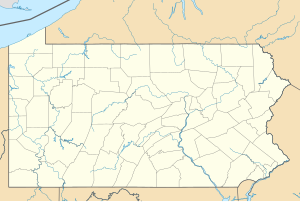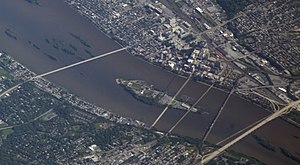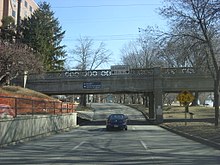Cumberland Valley Railroad Bridge
Coordinates: 40 ° 15 ′ 8 ″ N , 76 ° 53 ′ 6 ″ W.
| Cumberland Valley Railroad Bridge | ||
|---|---|---|
| use | Railway bridge | |
| Crossing of | Susquehanna River | |
| place | Harrisburg and Lemoyne , Pennsylvania | |
| construction | Arch bridge | |
| overall length | 1218 m | |
| width | 11 m | |
| Longest span | 27 m (between the central pillars) | |
| start of building | 1914 | |
| completion | 1916 | |
| location | ||
|
|
||
| Harrisburg with City Island on Susquehanna | ||
|
The bridges at the level of the river island from left to right: M. Harvey Taylor Memorial Bridge Walnut Street Bridge Market Street Bridge Cumberland Valley Railroad Bridge Philadelphia and Reading Railroad Bridge ( Dock Street Dam ) John Harris Bridge |
||
The Cumberland Valley Railroad Bridge is a former railroad bridge over the Susquehanna River between Harrisburg and Lemoyne in the state of Pennsylvania in the USA . At the site of today's reinforced concrete - arch bridge , there were several predecessors bridges since 1839 Cumberland Valley Railroad , which since 1859 under the control of the Pennsylvania Railroad stood and 1919 in this railway companies rose. The arched bridge replaced a single - track truss bridge made of wrought iron in 1916 , whereby the existing bridge was gradually converted into a reinforced concrete structure from 1914 onwards. The railroad bridges over the Susquehanna in the Harrisburg area went to Conrail in 1976 , who gave up the Cumberland Valley Railroad Bridge in favor of the neighboring Philadelphia and Reading Railroad Bridge . In the 1990s, the Capital Area Transit of the City of Harrisburg received the bridge, but a planned use for local public transport has not yet been implemented.
history
First railway bridge over the Susquehanna in 1839
Founded in 1835, the Cumberland Valley Railroad (CVRR) was one of the first railroad companies in Pennsylvania and was supposed to connect Carlisle with Harrisburg, where it connected to the Main Line of Public Works , the then Pennsylvania canal system . Construction began in the spring of 1836, the connection between Carlisle and today's Lemoyne - on the opposite bank of the river from Harrisburg - was put into operation in August 1837. In the years that followed, the line was extended to Chambersburg in the southwest and construction of a bridge over the Susquehanna began in the north, which was inaugurated in January 1839.
Like the neighboring Camel Back Bridge from 1817 (one of the predecessor bridges of today's Market Street Bridge ), it was a roofed wooden bridge in Burr-Truss construction , which also ran over the river island City Island . The Cumberland Valley Railroad Bridge was the second bridge over the Susquehanna and the first railroad bridge after the road bridge designed by Theodore Burr . It could also be used by pedestrians and horse-drawn carriages within the truss , as the track ran on the roof of the bridge. The bridge fell victim to a fire in December 1844 and was rebuilt in a similar construction method by the end of the 1850s and repaired and reinforced several times in the following years, which ultimately meant that it was not used as a road bridge.
From iron framework to reinforced concrete arch 1886–1916

Starting in 1886, a replaced truss bridge made of wrought iron , the old wooden bridge, which then thirty years later in today's reinforced concrete - arch bridge was rebuilt. In the 1910s, an average of 84 trains a day used the single-track iron bridge. In addition, with the advent of more powerful and therefore heavier steam locomotives , the load capacity was no longer sufficient. The bridge piers were sufficiently dimensioned for a later extension of the trusses for a second track, but the extension was rejected in favor of the conversion into a two-track massive arched bridge. 45 arches made of reinforced concrete replaced 21 truss and three shorter beam girders, for which new concrete pillars were erected between the truss girders and the old stone pillars were encased in concrete and integrated into the new arch bridge. In order to be able to continue operating the bridge during the renovation, the existing large stone pillars were used to move the narrower trusses by almost three meters from the center in the direction upstream, which created enough space for the construction of the first half of the arch bridge and the iron bridge can continue to be used for the time being could. Then the track was shifted to this newly built first half and the arched bridge was completed on the opposite side for the second track.
Takeover by Conrail in 1976 and closure
At the time the bridge was rebuilt, the CVRR was already under the control of the Pennsylvania Railroad (PRR), which became the largest shareholder in 1859 and benefited from the double-track expansion of the river crossing. In 1919, the CVRR finally became part of the significantly larger railway company. As a result of the later expansion of the road network and the emergence of motorized individual transport, the railroad transported fewer and fewer goods and people, which in the 1970s led to the bankruptcy of several railway companies in the eastern United States. These included Penn Central (successor to the PRR) and the Reading Company , the largest companies in the industry. As a result, the state rescue company Conrail was created, which also owned all the railway bridges over the Susquehanna. Necessary savings through network optimizations later forced Conrail to abandon the connection over the Cumberland Valley Railroad Bridge in favor of the route over the neighboring Philadelphia and Reading Railroad Bridge , a truss bridge also converted into a concrete arch bridge, which belonged to the Reading Company .
In the following period, the tracks on the bridge were removed, only the access on the east bank is still used for turning trains by Amtrak . In the 1990s, Conrail handed the bridge over to the Capital Area Transit of the city of Harrisburg, which was planning to use it for local public transport , but this has not yet been implemented (as of 2017). Since the beginning of the 2010s, the possible use of the bridge has returned to the focus, and an expansion as a footpath and cycle path is also being considered.
Construction work
Preparations
In the autumn of 1914, the CVRR began building the foundations for the new bridge piers and reinforcing the old ones. The work was necessary in this early phase of construction because the city of Harrisburg built the Dock Street Dam downstream , which raised the river level by 1.2 m at low tide from 1915 onwards. In the winter of 1914, the old 5.7 m wide iron lattice girders were moved from the center of the stone pillars by 2.6 m to the upstream side. This created enough space for the reconstruction of the first half of the bridge and at the same time the bridge could continue to be operated. The rest of the work was awarded to the Rober Grace Contracting Company from Pittsburgh following a tender in March 1915 , which began the construction of the southern half of the arched bridge downstream the following month.
Infrastructure for material transport

The bridge runs over a river island in the middle of the Susquehanna, which is about 100 m wide at this point and divides the river into two approximately 500 m wide arms. This made it possible to divide the renovation into four construction phases - west and east sides of each bridge half - and to minimize the amount of work and material used by reusing the necessary formwork and scaffolding. The city of Harrisburg, as the owner of the river island, allowed the construction of a concrete mixing plant , from which the concrete was transported to the construction sections by means of a material web. Served by a low trestle bridge , which comigrated with the phases and carried four rails, whereby the outside two tracks for the material web ( track width 914 mm) and inside a standard gauge -Gleis for rail cranes could be realized. An additional trestle bridge at the level of the bridge's platform level with a corresponding branching off from the main track made it possible to use self-unloading wagons to fill the concrete mixing plant that supplied the wagons of the material web below with concrete. The amount of concrete required was around 42,000 m³, plus around 5,700 m³ for the pillar foundations.
Construction of the arch bridge
Starting from the river island, the first halves of the bridge arches were built towards the Lemoyne bank on the downstream side, then the trestle bridge of the material web was moved to the east side of the bridge towards Harrisburg and the entire first half of the arch bridge was completed. The track on the old truss girders could then be relocated to this half of the arch bridge, the train traffic ran here from February 1916. Despite the loss of the low Trestle Bridge in the third construction phase - upstream between Harrisburg and the river island - during a flood in June 1916, was able to the arch bridge will be completed by the end of the year and the second track will be put into operation. The rapid construction progress was made possible in particular by shift work and reusable formwork for the arches and upper pillar sections, the steel frame of which could be fastened in specially provided recesses in the piers below the arch base ( fighter line ). The recesses can still be seen today, as can the neighboring Philadelphia and Reading Railroad Bridge , which was rebuilt using the same construction principle from 1920.
description

The arch bridge with a total length of 1217.7 m has a gradient of 5 ‰ from the west to the east bank in the direction of Harrisburg and consists of 45 reinforced concrete arches and a steel girder bridge on the Lemoyne side. As the spans of the former trusses varied between 51.8 m and 56.4 m, the difference in length of up to 2.6 m had to be compensated for by different pillar widths and arch widths. In order to minimize the effort for the formwork, only two arch widths were used, which could be achieved with a single adjustable type of formwork. The bridge is therefore made up of 22 arches with a clear width of 22.7 m and 23 arches with 23.5 m, whereby the newly erected pillars are 2.7 m wide, but the width of the old stone pillars covered with concrete is between 3.5 m and 4.6 m varies.
Arches and pillars
The arches are a combination of two stitch arches of different radii. The lower one with 14.4 m or 15.2 m (depending on the arc width) and the upper one, which faces the chip groove , with a larger radius of 18.3 m. As a result, the arch tapers to 91 cm at the top, the height of the spandex wall resting on it is a little over a meter, in the middle of the pillars 3.8 m. The inner arch cannot be seen on the facade , a parallel course with almost the same radii is indicated here. The continuous cavity of the chip grooves is provided with a bed of stone on which the tracks lie. 15 cm pipes are used for drainage from the center of the pillar to the respective outer transom line . A railing made of steel tubes forms the end of the superstructure . The pillars are about 11 m long, which corresponds to the width of the superstructure. Below the fighter line, they are reinforced over their entire width with a semicircular edge protection, which is provided with a slope upstream and here acts as an icebreaker .
Driveways and special features
On the west bank of the Susquehanna run two tracks of a former Pennsylvania Railroad (now operated by Norfolk Southern Railway ), which cross under the bridge between the second and third arch and are spanned by a 21 m long girder bridge made of solid wall girders . Here, the CVRR replaced one of the truss girders with an overhead track at the time of the iron bridge in order to ensure sufficient headroom for the PRR trains. The three bridge piers following in the direction of the middle of the river are longer because a track used to branch off from the bridge here, which also crossed the PRR line on girder bridges. In the Harrisburg metropolitan area, the arch bridge is complemented by a reinforced concrete girder bridge that spans South Front Street . The double-track connection over the bridge was electrified before it was closed , the catenary masts were erected at regular intervals above the bridge piers and are still there today.
literature
- TA Baldwin: History of the Old Cumberland Valley Railroad Bridge at Harrisburg, and the Transverse Shifting of the Present Iron Structure. In: Journal of the Engineers Society of Pennsylvania. Vol. 7, No. 1 and 2, 1915, pp. 258-264.
- Little Plant Required to Complete 4000-Foot Railroad Bridge. In: Engineering Record. Vol. 74, No. 12, 1916, pp. 340-342.
- Susquehanna Concrete Viaduct Built in Halves. In: Engineering News. Vol. 75, No. 12, 1916, pp. 537-540.
- Building Second Half of the Susquehanna Bridge. In: Engineering News. Vol. 76, No. 16, 1916, pp. 764-766.
- New Susquehanna River Bridge at Harrisburg. In: Railway Age Gazette. Vol. 60, No. 11, 1916, pp. 501-503.
Web links
- Cumberland Valley Railroad Bridge. HistoricBridges.org
- Cumberland Valley Railroad Historical Marker. ExplorePAhistory.com
Individual evidence
- ^ Rural Resorts and Summer Retreats Along the Line of the Cumberland Valley Railroad. Cumberland Valley Railroad Company, 1881, pp. 7 f.
- ↑ a b Cumberland Valley Railroad Historical Marker. ExplorePAhistory.com, accessed December 20, 2017.
- ^ A b T. A. Baldwin: History of the Old Cumberland Valley Railroad Bridge at Harrisburg, and the Transverse Shifting of the Present Iron Structure. In: Journal of the Engineers Society of Pennsylvania. Vol. 7, No. 1 and 2, 1915, pp. 258-264.
- ^ New Susquehanna River Bridge at Harrisburg. In: Railway Age Gazette. Vol. 60, No. 11, 1916, pp. 501-503.
- ^ A b Justin M. Spivey: Philadelphia & Reading Railroad, Susquehanna River Bridge. Historic American Engineering Record, HAER No. PA-523, Washington, DC 2001, pp. 3 f.
- ↑ Nick Malawskey: Crossing the Susquehanna: Will an old railroad (re) connect the East and West shores? PennLive, October 15, 2013. Retrieved December 22, 2017.
- ↑ Nick Malawskey: Bridge to nowhere no more? Funding for Susquehanna pedestrian bridge approved. PennLive, June 20, 2014. Retrieved December 22, 2017.
- ^ Daniel Walmer: Harrisburg Area Transportation Study plan takes aim at West Shore. The Sentinal, December 26, 2014. Retrieved December 22, 2017.
- ↑ a b c d e New Susquehanna River Bridge at Harrisburg. In: Railway Age Gazette. Vol. 60, No. 11, 1916, pp. 501-503.
- ↑ Little Plant Required to Complete 4000-Foot Railroad Bridge. In: Engineering Record. Vol. 74, No. 12, 1916, pp. 340-342.
- ^ First Train Crosses New Cumberland Valley Bridge. In: Engineering Record. Vol. 73, No. 7, 1916, p. 229.
- ^ A b Building Second Half of the Susquehanna Bridge. In: Engineering News. Vol. 76, No. 16, 1916, pp. 764-766.
- ^ New Susquehanna River Bridge at Harrisburg. In: Railway Age Gazette. Vol. 60, No. 11, 1916, p. 502.
- ↑ Susquehanna Concrete Viaduct Built in Halves. In: Engineering News. Vol. 75, No. 12, 1916, p. 539.
- ↑ Susquehanna Concrete Viaduct Built in Halves. In: Engineering News. Vol. 75, No. 12, 1916, pp. 537-540.
- ^ Pennsylvania Railroad Map. Pennsylvania Department of Transportation, January 2017. Retrieved January 5, 2018.







